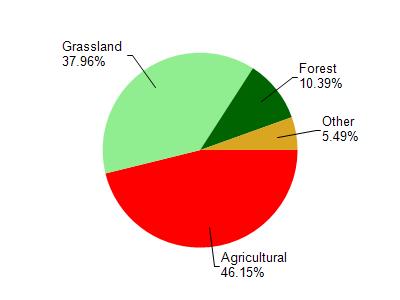Grant
No
No
No
Fish and Aquatic Life
Overview
This seven mile long tributary to the Little Platte River occasionally contains smallmouth bass in the lower reaches, but mostly it functions as a coolwater forage fishery. The stream has a hard bottom of rubble/cobble and gravel owing to its good gradient, but much of the stream corridor and subwatershed is heavily pastured and the stream is fairly wide and shallow. In 1978, good numbers of Ozark minnows were found in the stream. Subsequent surveys in 2005 and 2009 showed the presence of high numbers of forage species such as fantail darters, blacknose dace, central stonerollers, and common shiners, but no Ozark minnows were found.
Date 2011
Author James Amrhein
Historical Description
A moderate-gradient spring-fed stream beginning near Georgetown and flowing northwest to enter the Little Platte River 1.5 miles north of Dickeyville. This stream is subject to severe floods, and heavy bank erosion is evident. The lower portion of the stream is characterized bya highly sandy stream bed. The upper half exhibits a wide boulder-rubble strewn bottom which indicates a more rapid amount of runoff in this area. Nearly 90 percent of the watershed has been cleared for agricultural purposes and overgrazing is a problem along the stream banks. A few smallmouth bass "provide a limited fishery in the lower reaches. Forage species, including white suckers, bluntnose minnows, common shiners, redbelly dace, and creek chubs are common. Crayfish are also common throughout the stream. Aquatic game assets are restricted to a few muskrats near the mouth. Upland game species are seen thrQughout the watershed. Barnyard runoff is a major problem " found along many sections of the stream. The Little Platte River and two bridge crossings provide adequate points of access, and four dwellings adjoin the stream.
From: Smith, Tom D., and Ball, Joseph R., Lake and Stream Classification Project. Surface Water Resources of Grant County, Department of Natural Resources, 1972. Surface Area 7.09 acres, Length 6.5 miles, Gradient 45 ft./mile, Flow = 5.1 c.f.s.
Date 1972
Author Aquatic Biologist
Condition
Wisconsin has over 84,000 miles of streams, 15,000 lakes and milllions of acres of wetlands. Assessing the condition of this vast amount of water is challenging. The state's water monitoring program uses a media-based, cross-program approach to analyze water condition. An updated monitoring strategy (2015-2020) is now available. Compliance with Clean Water Act fishable, swimmable standards are located in the Executive Summary of Water Condition in 2018. See also the 'monitoring and projects' tab.
Reports
Management Goals
Wisconsin's Water Quality Standards provide qualitative and quantitative goals for waters that are protective of Fishable, Swimmable conditions [Learn more]. Waters that do not meet water quality standards are considered impaired and restoration actions are planned and carried out until the water is once again fishable and swimmable
Management goals can include creation or implementation of a Total Maximum Daily Load analysis, a Nine Key Element Plan, or other restoration work, education and outreach and more. If specific recommendations exist for this water, they will be displayed below online.
Monitoring
Monitoring the condition of a river, stream, or lake includes gathering physical, chemical, biological, and habitat data. Comprehensive studies often gather all these parameters in great detail, while lighter assessment events will involve sampling physical, chemical and biological data such as macroinvertebrates. Aquatic macroinvertebrates and fish communities integrate watershed or catchment condition, providing great insight into overall ecosystem health. Chemical and habitat parameters tell researchers more about human induced problems including contaminated runoff, point source dischargers, or habitat issues that foster or limit the potential of aquatic communities to thrive in a given area. Wisconsin's Water Monitoring Strategy was recenty updated.
Grants and Management Projects
| Project Name (Click for Details) | Year Started |
|---|
|
|
Monitoring Projects
| WBIC | Official Waterbody Name | Station ID | Station Name | Earliest Fieldwork Date | Latest Fieldwork Date | View Station | View Data |
|---|
| 944200 | McAdam Branch | 223243 | Mcadam Br - Sth 151 (Bi) | 5/10/1979 | 5/21/2001 | Map | Data |
| 944200 | McAdam Branch | 10012762 | Mcadam Branch | | | Map | Data |
| 944200 | McAdam Branch | 10030378 | McAdam Branch 10 m upstream of Morgan Road | 10/29/2009 | 1/1/2015 | Map | Data |
| 944200 | McAdam Branch | 10039317 | McAdam Branch at McAdam Rd | 6/5/2015 | 6/5/2015 | Map | Data |
| 944200 | McAdam Branch | 223342 | Mcadam Branch - Near Dickeyville WI | 6/18/2001 | 10/15/2001 | Map | Data |
|

Watershed Characteristics
McAdam Branch is located in the Little Platte River watershed which is 154.94 mi². Land use in the watershed is primarily agricultural (46.20%), grassland (38%) and a mix of forest (10.40%) and other uses (5.50%). This watershed has 389.19 stream miles, 19.99 lake acres and 585.06 wetland acres.
Nonpoint Source Characteristics
This watershed is ranked High for runoff impacts on streams, Not Available for runoff impacts on lakes and High for runoff impacts on groundwater and therefore has an overall rank of High. This value can be used in ranking the watershed or individual waterbodies for grant funding under state and county programs.However, all waters are affected by diffuse pollutant sources regardless of initial water quality. Applications for specific runoff projects under state or county grant programs may be pursued. For more information, go to surface water program grants.